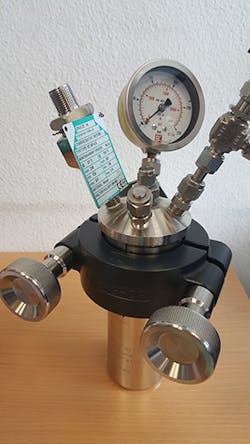Simpler Synthesis Of Active Ingredients Beckons
Many pharmaceuticals and agrochemicals rely on fluorinated piperidines. However, combining small ring-shaped piperidines with fluorine atoms to create these active ingredients always has been a laborious and difficult task. Now, chemists in Germany have developed a simple synthesis route that builds upon a reaction breakthrough they made in 2017.
The method developed by Frank Glorius, a professor of organic chemistry at the Westfälische Wilhelms-Universität in Münster, and his team requires two consecutive steps — but in the same reaction vessel and using a single catalyst. The researchers produce the active ingredients in a 170-ml vessel operating at 50 bar hydrogen at 25–40°C.
The first step involves the dearomatization of easily accessible, chemically inert fluorinated pyridines. In the second step, a hydrogenation reaction transfers hydrogen atoms to one side of the pyridine ring system.
“This dearomatization-hydrogenation sequence is a one-pot process that doesn’t require the isolation or purification of the intermediates. We simply mix all reagents together and then set the vessel at the required pressure of hydrogen,” explains Glorius.
The reaction changes the essentially flat fluorinated pyridine molecules into much more structurally complicated and active fluorinated piperidines.
Figure 1. New method simplifies production of active fluorinated piperidines. Source: Zackaria Nairoukh/Westfälische Wilhelms-Universität Münster.
Besides the important fluorinated piperidines, the reaction generates other fluorinated nitrogen-heterocycles. “These are also significant structural components of pharmaceuticals and natural products. With the introduction of fluorine functionality into these moieties, their incorporation in drug candidates is expected to improve the pharmacokinetic and physicochemical properties and hence increase the likelihood of success in clinical trials,” notes Glorius.
The research project, which initially will run for five years, has attracted €2.5 million ($2.8 million) in funding from the European Research Council.
“We really hope to make significant progress within this time so that better catalysts can be developed and the potential of these reactions can be exploited to the full,” he adds.
The main challenges in scaling up the process lie in reagent purity, says Glorius. “The reaction can tolerate oxygen and traces of water but, for an efficient process, all reagents as well as the solvent used must be dry.” That shouldn’t pose a major barrier to producing the compounds in large quantities, he believes.
The now-patented process has attracted industrial interest, with an unnamed company already commercializing some of its products.

